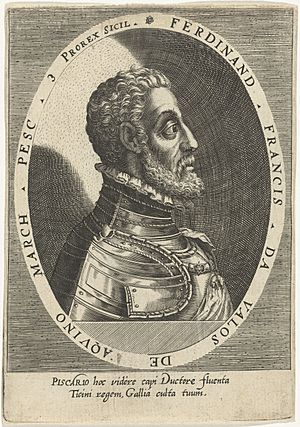Fernando d'Ávalos facts for kids
Fernando Francesco d'Ávalos (born November 11, 1489 – died December 3, 1525) was a famous Italian general. He was also known as Ferrante Francesco d'Ávalos. His family came from Aragon, Spain. He played a very important role in the Italian Wars. These wars were a series of conflicts in Italy. He led the armies of Emperor Charles V and won major battles. These included the Battle of Bicocca and the Battle of Pavia.
Contents
Early Life and Military Beginnings
Fernando was born in Naples, Italy. However, his family was originally from Aragon, a region in Spain. His grandfather, Iñigo I d'Ávalos, came to southern Italy with King Alfonso V of Aragon. Fernando's father was Alfonso d'Ávalos d'Aquino, 4th marquis of Pescara.
Fernando always felt like a Spaniard. He spoke Spanish, even with his wife. He was always surrounded by Spanish soldiers and officers. His father died during a French invasion of Naples when Fernando was a baby.
At age six, Fernando was promised to Vittoria Colonna. She was the daughter of the general Fabrizio Colonna. They married in 1509 on the island of Ischia. Because he was a noble from the Aragonese party in Naples, he supported King Ferdinand the Catholic in his wars in Italy.
Key Battles and Leadership
In 1512, Fernando commanded light cavalry at the Battle of Ravenna. He was wounded and captured by the French. A French general, Gian Giacomo Trivulzio, who was related to him by marriage, helped him. Fernando was allowed to pay a ransom and be released.
He then led the Spanish infantry at the Battle of La Motta (also called Vicenza) on October 7, 1513. Before a charge, he told his men to step on him if he fell, rather than let the enemy do it. This showed his bravery and dedication.
From 1513 to 1522, he continued to serve as a leader of the Spanish troops. He worked alongside Prospero Colonna, another important general.
After the Battle of Bicocca in 1522, Emperor Charles V made Colonna the main commander. D'Ávalos felt he deserved the position. He traveled to Valladolid, Spain, to speak with the emperor. Charles V had long, private talks with him. The emperor convinced him to accept Colonna's leadership for a while. During these meetings, d'Ávalos gained Charles V's trust. His Spanish background made him a safer choice to lead the imperial troops in Italy than an Italian general might have been.
Victory at Pavia and Final Years
In 1524, King Francis I of France invaded Italy. D'Ávalos was chosen by Emperor Charles V to stop the invasion. His job was very difficult. The army was unhappy because they were not paid well. But d'Ávalos was very determined, patient, and skillful. He overcame all problems. His strong influence kept the experienced Spanish soldiers and German mercenaries loyal during the long siege of Pavia.
On February 24, 1525, he led a brilliant attack. He defeated King Francis I and took him prisoner. D'Ávalos's plan was very bold. He skillfully destroyed the stronger French heavy cavalry. He attacked them from the side with a mix of harquebusiers (soldiers with early firearms) and light cavalry.
Some people thought d'Ávalos was unhappy with the emperor. Girolamo Morone, a secretary to the Duke of Milan, approached him. Morone suggested a plan to remove all French, Spanish, and German forces from Italy. He also offered d'Ávalos a throne for himself. D'Ávalos might have listened, but he remained loyal. He told Charles V about the offer and had Morone arrested.
His health began to fail due to his wounds and being exposed to harsh conditions. He died in Milan on December 3, 1525.
Family Life
Fernando Francesco d'Ávalos did not have any children. His title passed to his cousin, Alfonso d'Avalos. Alfonso d'Ávalos was also a well-known imperial general. He led the imperial musketeers at the Battle of Pavia.
In Books and Plays
The Italian historian Paolo Giovio wrote a biography of Fernando Francesco in Latin. This book was later translated into Italian and Spanish.
The novel Die Versuchung des Pescara (The Temptation of Pescara) by Conrad Ferdinand Meyer is about him.
He is also mentioned many times in John Webster's play 'The Duchess of Malfi'. This play was first performed around 1613–1614.
See also
 In Spanish: Fernando de Ávalos para niños
In Spanish: Fernando de Ávalos para niños



